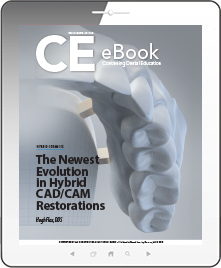CDEWorld > eBooks > The Newest Evolution in Hybrid CAD/CAM Restorations


ADA CERP is a service of the American Dental Association to assist dental professionals in identifying quality providers of continuing dental education. ADA CERP does not approve or endorse individual courses or instructors, nor does it imply acceptance of credit house by boards of dentistry. Concerns or complaints about a CE provider may be directed to the provider or to ADA CERP at www.ada.org/cerp/

Approved PACE Program Provider. FAGD/MAGD credit. Approval does not imply acceptance by a state or provincial board of dentistry, or AGD endorsement. 1/1/2023 to 12/31/2028. ID # 209722.
eBook
Released: Saturday, December 29, 2018
Expires: Friday, December 31, 2021
The Newest Evolution in Hybrid CAD/CAM Restorations
By Hugh Flax, DDS
Commercial Supporter: Shofu
This article will explore CAD/CAM technology in relation to the main challenges it was developed to address: adequate strength of restorations, especially for posterior teeth; giving restorations a natural appearance; and making tooth restoration easier, faster, and more accurate. CAD/CAM restorations will be reviewed from a historical perspective, concluding with a description of newer ceramic materials, particularly a newer hybrid ceramic (HC) described in the context of a case study.
LEARNING OBJECTIVES:
-
Describe the challenges that CAD/CAM technology was designed to address.
-
Describe the characteristics of newer ceramics, including hybrid ceramics.
-
Discuss the impact of CAD/CAM restorations on dentistry.
About the Author
Hugh Flax, DDS
Private Practice
Atlanta, Georgia


